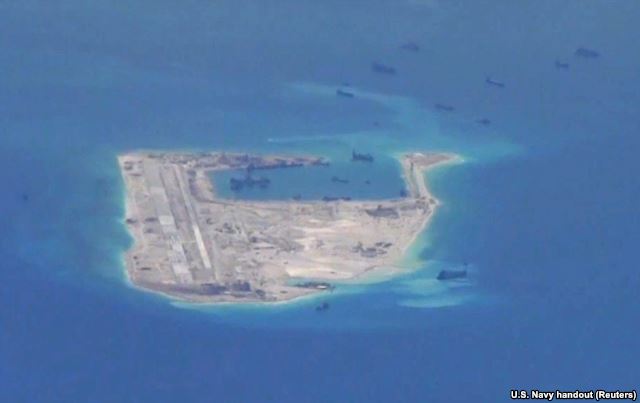The US must take action in the South China Sea
October 10, 2018
Just this Sunday, an US warship almost collided with a Chinese destroyer; the ships had purportedly sailed within just meters of each other. Despite the shocking nature of the incident, this recent development is nothing new in the string of events that have transpired in the South China Sea.
The roots of the conflict date back to the end of World War II, when a multitude of East Asian nations laid claims to specific islands in the Spratly Archipelago, located in the South China Sea. Although territorial boundaries have been disputed since then, tensions spiked in 2014 when China began to artificially build up the reefs they claimed.
In a process known as dredging, China used the surrounding sand to build landmasses on these reefs. On these lands, they have installed missile defense systems, airstrips, and stationed fighter jets – all to reaffirm what they believe to be their rightful claim to these reefs.
However, China’s claims are a blatant violation of both international law, specifically the United Nations Convention on the Law of the Sea, and the sovereignty of its surrounding neighbors. Because of this, the US must take a stronger stance against it to maintain stability in the surrounding region.
In addition to implicitly allowing the subjugation of our allies, leaving Chinese aggression unchecked is undermining stability in the region as a whole. As China’s territorial claims become more forceful and intrusive, countries are fearing for their sovereignty and security.
The South China Sea dispute is described by many as a defining moment in the 21st century – the interactions between two of the world’s major hegemonic powers, the United States and China, will have far-reaching implications on societies everywhere. How we approach this incident will greatly affect our future relations with our primary rival and shape our foreign policy for decades to come.
Yet, we are taking far too weak of a stance.
Currently, the United States’ policy centers around utilizing a series of unilateral military exercises called “Freedom of Navigation Operations”, challenging China’s island building by navigating through waters that China claims to have sovereignty over. However, this approach is both weak and ineffective, given it angers both China and our regional allies.
The operations started with Obama’s pivot to Asia, and have been continued through the Trump presidency. But, besides occasionally confronting Chinese ships, they have done little to contain Chinese aggression.
Instead, what we need is a coordinated approach with our regional allies.
However, due to Trump’s withdrawal of a multitude of multilateral treaties, US international standing has been rapidly declining in the past two years. However, now is the time to recommit through multilateralism.
Regional allies are desperate for our help; they just need a signal that the US is willing to work with them. In fact, Philippines president Rodrigo Duterte specifically cited our recent absence from the Trans Pacific Partnership as the root of his uncertainty of US commitment.
With a multilateral alliance, the United States can band together with allies to use economic and political disincentives to check back for Chinese aggression. A united front is the only way forward.
Photo used with permission from the US Department of Defense.











